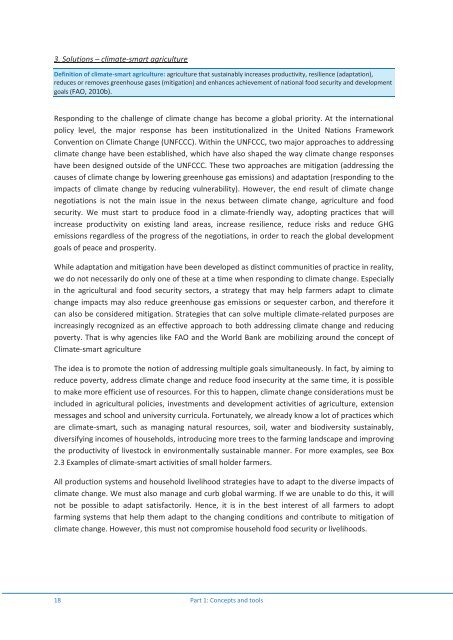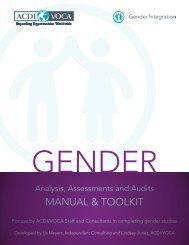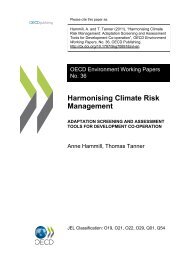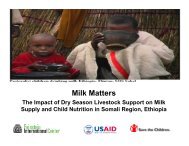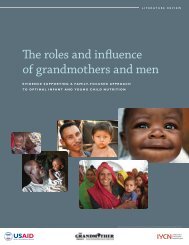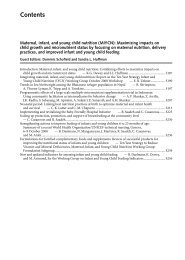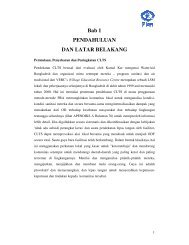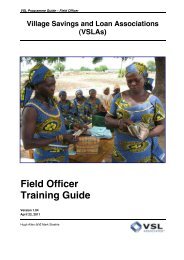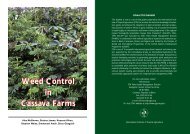Gender and climate change research in - FAO
Gender and climate change research in - FAO
Gender and climate change research in - FAO
Create successful ePaper yourself
Turn your PDF publications into a flip-book with our unique Google optimized e-Paper software.
3. Solutions – <strong>climate</strong>-smart agriculture<br />
Def<strong>in</strong>ition of <strong>climate</strong>-smart agriculture: agriculture that susta<strong>in</strong>ably <strong>in</strong>creases productivity, resilience (adaptation),<br />
reduces or removes greenhouse gases (mitigation) <strong>and</strong> enhances achievement of national food security <strong>and</strong> development<br />
goals (<strong>FAO</strong>, 2010b).<br />
Respond<strong>in</strong>g to the challenge of <strong>climate</strong> <strong>change</strong> has become a global priority. At the <strong>in</strong>ternational<br />
policy level, the major response has been <strong>in</strong>stitutionalized <strong>in</strong> the United Nations Framework<br />
Convention on Climate Change (UNFCCC). With<strong>in</strong> the UNFCCC, two major approaches to address<strong>in</strong>g<br />
<strong>climate</strong> <strong>change</strong> have been established, which have also shaped the way <strong>climate</strong> <strong>change</strong> responses<br />
have been designed outside of the UNFCCC. These two approaches are mitigation (address<strong>in</strong>g the<br />
causes of <strong>climate</strong> <strong>change</strong> by lower<strong>in</strong>g greenhouse gas emissions) <strong>and</strong> adaptation (respond<strong>in</strong>g to the<br />
impacts of <strong>climate</strong> <strong>change</strong> by reduc<strong>in</strong>g vulnerability). However, the end result of <strong>climate</strong> <strong>change</strong><br />
negotiations is not the ma<strong>in</strong> issue <strong>in</strong> the nexus between <strong>climate</strong> <strong>change</strong>, agriculture <strong>and</strong> food<br />
security. We must start to produce food <strong>in</strong> a <strong>climate</strong>-friendly way, adopt<strong>in</strong>g practices that will<br />
<strong>in</strong>crease productivity on exist<strong>in</strong>g l<strong>and</strong> areas, <strong>in</strong>crease resilience, reduce risks <strong>and</strong> reduce GHG<br />
emissions regardless of the progress of the negotiations, <strong>in</strong> order to reach the global development<br />
goals of peace <strong>and</strong> prosperity.<br />
While adaptation <strong>and</strong> mitigation have been developed as dist<strong>in</strong>ct communities of practice <strong>in</strong> reality,<br />
we do not necessarily do only one of these at a time when respond<strong>in</strong>g to <strong>climate</strong> <strong>change</strong>. Especially<br />
<strong>in</strong> the agricultural <strong>and</strong> food security sectors, a strategy that may help farmers adapt to <strong>climate</strong><br />
<strong>change</strong> impacts may also reduce greenhouse gas emissions or sequester carbon, <strong>and</strong> therefore it<br />
can also be considered mitigation. Strategies that can solve multiple <strong>climate</strong>-related purposes are<br />
<strong>in</strong>creas<strong>in</strong>gly recognized as an effective approach to both address<strong>in</strong>g <strong>climate</strong> <strong>change</strong> <strong>and</strong> reduc<strong>in</strong>g<br />
poverty. That is why agencies like <strong>FAO</strong> <strong>and</strong> the World Bank are mobiliz<strong>in</strong>g around the concept of<br />
Climate-smart agriculture<br />
The idea is to promote the notion of address<strong>in</strong>g multiple goals simultaneously. In fact, by aim<strong>in</strong>g to<br />
reduce poverty, address <strong>climate</strong> <strong>change</strong> <strong>and</strong> reduce food <strong>in</strong>security at the same time, it is possible<br />
to make more efficient use of resources. For this to happen, <strong>climate</strong> <strong>change</strong> considerations must be<br />
<strong>in</strong>cluded <strong>in</strong> agricultural policies, <strong>in</strong>vestments <strong>and</strong> development activities of agriculture, extension<br />
messages <strong>and</strong> school <strong>and</strong> university curricula. Fortunately, we already know a lot of practices which<br />
are <strong>climate</strong>-smart, such as manag<strong>in</strong>g natural resources, soil, water <strong>and</strong> biodiversity susta<strong>in</strong>ably,<br />
diversify<strong>in</strong>g <strong>in</strong>comes of households, <strong>in</strong>troduc<strong>in</strong>g more trees to the farm<strong>in</strong>g l<strong>and</strong>scape <strong>and</strong> improv<strong>in</strong>g<br />
the productivity of livestock <strong>in</strong> environmentally susta<strong>in</strong>able manner. For more examples, see Box<br />
2.3 Examples of <strong>climate</strong>-smart activities of small holder farmers.<br />
All production systems <strong>and</strong> household livelihood strategies have to adapt to the diverse impacts of<br />
<strong>climate</strong> <strong>change</strong>. We must also manage <strong>and</strong> curb global warm<strong>in</strong>g. If we are unable to do this, it will<br />
not be possible to adapt satisfactorily. Hence, it is <strong>in</strong> the best <strong>in</strong>terest of all farmers to adopt<br />
farm<strong>in</strong>g systems that help them adapt to the chang<strong>in</strong>g conditions <strong>and</strong> contribute to mitigation of<br />
<strong>climate</strong> <strong>change</strong>. However, this must not compromise household food security or livelihoods.<br />
18 Part 1: Concepts <strong>and</strong> tools


